Category: Idaho Military Divison
Idaho Medical Airmen Train in Field to Boost Readiness
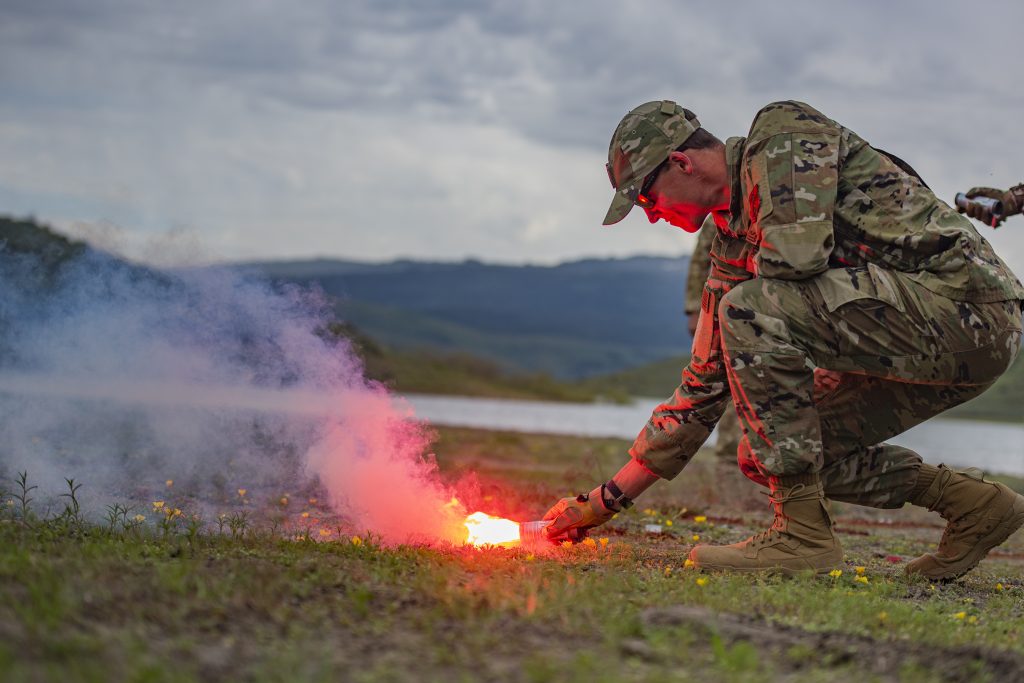
MOUNTAIN HOME, Idaho – Airmen from the Idaho Air National Guard’s 124th Medical Group trained in a field environment near Little Camas Reservoir in Elmore County June 5-8 to prepare for future deployments.
“The intent for this field training was to get the entire medical group exposed to the field environment for deployment readiness, as well as pushing comfort zones and team building,” said Maj. Mark Urban, critical care air transport team physician.
About 65 medical personnel practiced treating and stabilizing casualties using tactical combat casualty care in a simulated deployed location while defending medical structures and personnel.
Master Sgt. Raymond Perez, 124th Fighter Wing survival, evasion, resistance and escape specialist, trained the Airmen to survive in intense situations in unfamiliar surroundings.
“The medical teams will be geographically separated from the hospitals while deployed, functioning from a forward operating base,” said Perez. “I am training them on personal protection, clothing, building shelters, building fires, mental and physical health, environmental safety and protection, water purification and food sustenance. We are going to find food in the area, anywhere from vegetation on the ground to hunting animals that we will cook and eat.”
Medical personnel focused on tactical combat casualty care, point of injury, patient packaging, calling in a 9-Line medevac, patient movement, ground treatment and prolonged field care. Perez trained them on map and compass skills, signaling and recovery and making ground-to-air signals with flares for air rescue.
Idaho National Guardsmen, German JTACs reinforce relationships through training
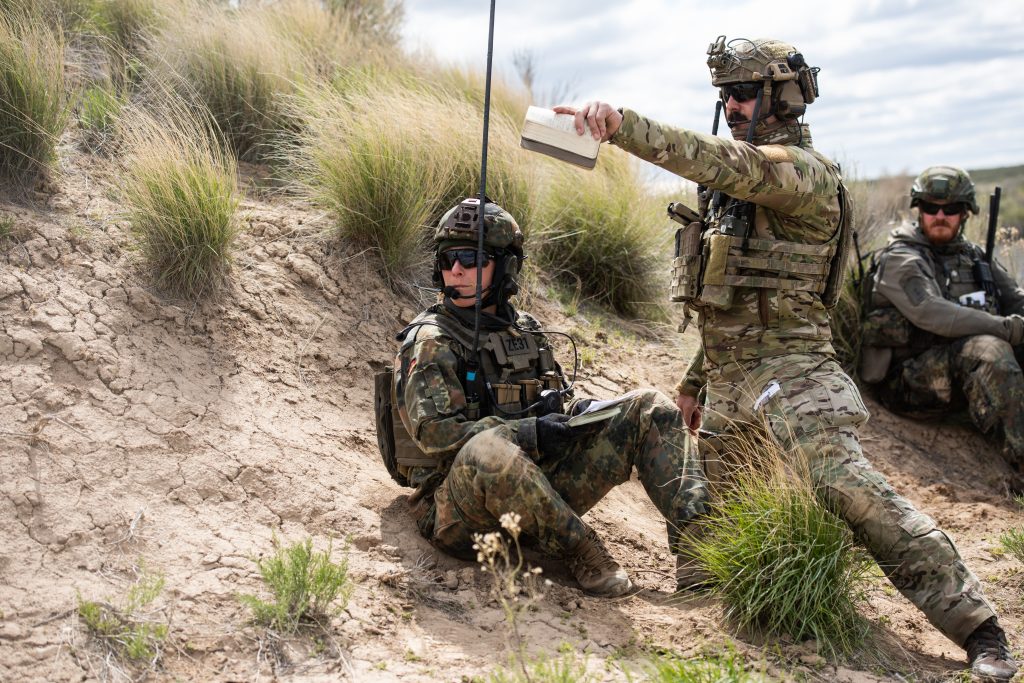
In 2015, an enlisted Idaho Air National Guardsman and a German Army lieutenant attended the same Joint Terminal Attack Controller Qualification Course and began a friendship that has had international implications for the past eight years. The two engaged in a series of conversations throughout their time at the course that resulted in a lasting partnership between the Idaho National Guard and the German military.
Master Sgt. Justin Clark, a senior airman at the time, is now a JTAC program coordinator with the 124th Air Support Operations Squadron. Clark said he immediately began looking for opportunities to bring the lieutenant’s unit to Idaho upon his return from the course. He said his unit commander’s support was key to guiding him through the process of coordinating and facilitating the German JTAC unit’s first visit to Gowen Field in the spring of 2016. The unit has returned every year since.
“The win, where it gets better every year, is the partnership,” said Clark. “We share lessons learned, and everyone’s experience culminates to make both parties better.”
This year, soldiers and airmen from Germany’s Joint Terminal Attack Controller Competence Center partnered with the Idaho Air National Guard’s 124th Fighter Wing to conduct close air support training at the Saylor Creek and Juniper Butte Ranges, Idaho, May 1-18. Idaho Army National Guard UH-60 pilots and crew also supported portions of the training, adding another layer of realism to the German troops training and further expanding their nearly decade-long partnership. The joint training incorporated NATO tactics, techniques and procedures, utilizing A-10 Thunderbolt II aircraft to prosecute targets ranging from armor, artillery, bunkers, simulated enemy combatants, moving targets, surface to air threats and more.
The visiting joint terminal attack controllers coordinate, integrate and direct the actions of combat aircraft engaging in close air support operations and joint fire observers, who augment JTACs by relaying target data. Leading them was Clark’s former classmate, Maj. Andreas Marx. Now a JTAC instructor himself, he said taking advantage of Idaho’s vast military range complex to enhance his unit’s training and further strengthen the international partnership is a win-win partnership.
“The CAS training opportunity that we have here, in conjunction with our partners from the 124th Fighter Wing is invaluable to us,” Marx said. “We do focus our training very much on large scale combat operations scenarios in the European theater of operations. Our partnership provides both sides with a common understanding and shared TTPs that will be of utmost importance during possible future conflicts with near-peer enemies.”
Located approximately 43 miles southeast of Gowen Field, Saylor Creek Range offers an impact area three miles wide by six miles long, where air and ground assets can employ live munitions.The Juniper Butte Range is located on 110,000 acres in southern Idaho and is covered with simulated hostile radar facilities, most of which are moveable electronic “threats. The range complex consists of two mock surface to air missile site targets in two strafe pits, a command site, a mock rail yard protected by two SAM sites, a radar/radio jamming tower and a range maintenance depot.
Master Sgt. Dennis Goettel, a joint fires platoon sergeant with the German Army, said the training site is unlike anything they have in Germany.
“In Germany, our soldiers never get into realistic situations like they do in Idaho because of training restrictions,” said the platoon sergeant. “It helps our soldiers to see live munitions hit their targets because then they know what they say to pilots really matters.”
In addition to the training, 124th ASOS Airmen and their German guests participate in other military exchange activities. This year, the units completed German and ASOS physical fitness assessments, and the Germans conducted shoot-and-move 9mm pistol and M4 carbine qualification courses for the Guardsmen.
Clark said the unit is expected to return to Gowen Field for another training event in August, when it will fully integrate with the 124th ASOS to conduct full mission profiles encompassing the squadron’s focus points – shoot, move, communicate, practice combat medicine and fitness.
Air Force’s 582nd Helicopter Group trains at OCTC
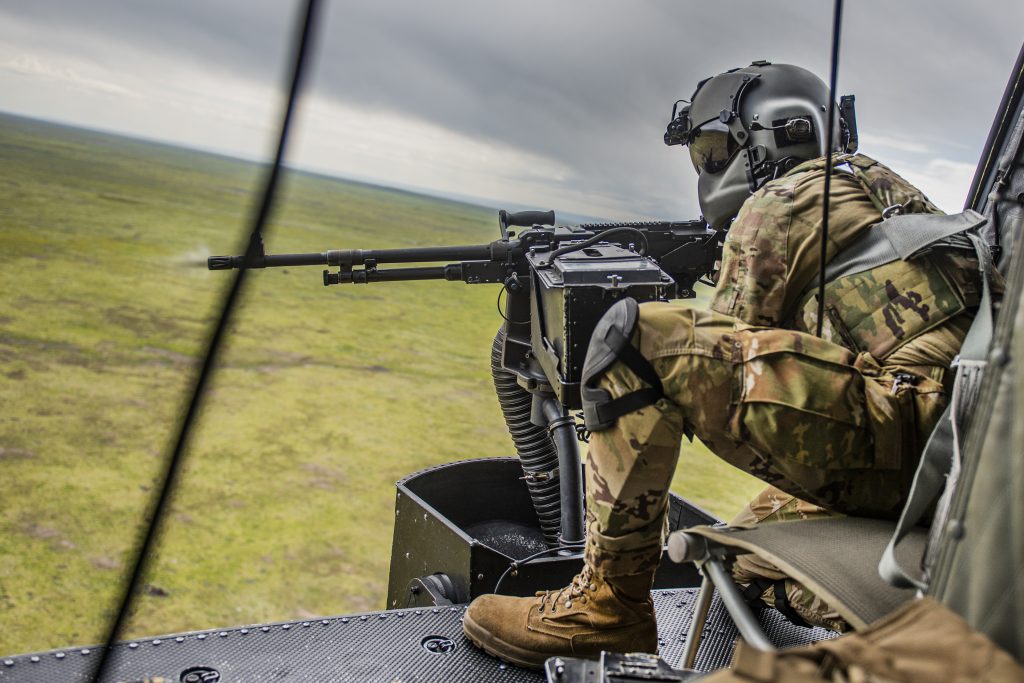
The Air Force’s 582nd Helicopter Group, conducted aerial gunnery training at the Orchard Combat Training Center April 15-26 to ensure its pilots and flight engineers are ready and able to provide airborne security operations.
The squadron, headquartered at F.E. Warren Air Force Base in Cheyenne, Wyoming, is geographically separated with squadrons in Montana, North Dakota and Wyoming, Its members fly security response missions, enabling key Task Force 214 operations supporting nuclear security missions for 450 intercontinental ballistic missile sites throughout the region.
The training, which incorporated elements from all three states, serves a dual purpose, said Air Force Capt. Nick Curren, a UH-1N Huey pilot and mission commander for the training evolution. Flight engineers are focused on conducting pre-flight weapons checks, remediating weapons malfunctions and engaging targets on the range, while pilots are focused on maneuvering the aircraft to maximize engineers’ opportunities for success. The end result should be a tighter, more proficient crew.
Curren, along with many of his fellow Airmen, is training at the OCTC for the first time. Most of the squadron’s similar training exercises take place at bases in Canada, Minnesota, Utah and Wyoming, but the OCTC’s reputation and amenities made the decision to train in Idaho an easy one, he said.
“We’ve only ever heard good things about the range,” said Curren. “This is also my first time as a mission commander, and the people here have been great about answering all my questions and helping me make sure we are doing everything we need to do to make this a success.”
Idaho’s OCTC is a premier joint combined arms training site with 171,000 acres and 23 world-class ranges.
Youth ChalleNGe Academy breaks ground on new barracks

The Idaho Youth Challenge Academy broke ground on a new barracks building April 9 in Pierce. Representatives from the Idaho National Guard gathered for the ceremony along with staff members from Gov. Brad Little’s office.
The $13.5 million, 18,000 square foot building will replace temporary billeting facilities currently in use at the academy. The new barracks also allows for potential expansion of the program with room to house up to 180 students and cadre.
Academy Director Trevor Sparrow said building strong relationships has been an important aspect of its success and growth over the years.
“We are so grateful for the support of all of our partners around the state from the cadets who attend, their families, local businesses and communities, the Idaho State Legislature and the Governor’s office,” said Sparrow. “This building solidifies the commitment that Idaho has to ensure the Idaho Youth ChalleNGe Academy stands ready to ensure a legacy of excellence for decades to come.”
The Idaho Youth ChalleNGe Academy opened its doors in 2014 with the mission “to intervene in and reclaim the lives of at-risk youth to produce program graduates with the values, skills, education and self-disciple necessary to succeed as responsible and productive citizens and adults.” Since then, the academy’s focus on providing education and developing employment and life skills among its student body has helped more than 2,000 Idaho youth earn traditional or general education diplomas.
Maj. Gen. Michael Garshak, Idaho adjutant general and commander of the Idaho National Guard, served as the presiding official during the ceremony.
“Two thousand and seventy-five young men and women from the state of Idaho have completed this and have really improved the citizenship and the future for our state,” said Garshak. “It’s time now that we move out of a temporary facility and build permanent barracks because I think the Youth ChalleNGe Academy has demonstrated that it is here to stay.”
The project is slated to be completed in November 2025.
Bolt assumes command of Alpha Company ‘Animals’
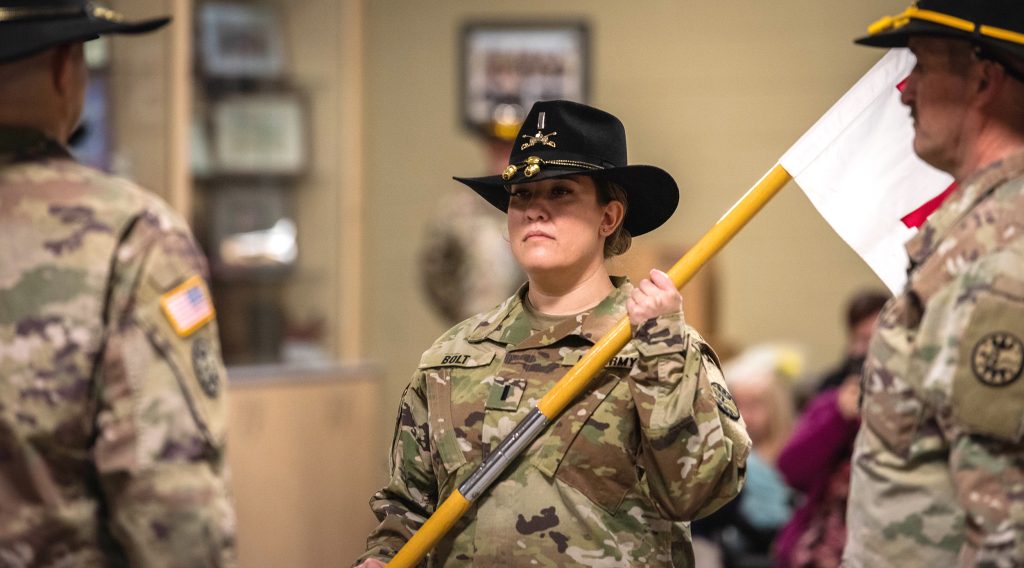
1st Lt. Lauren Bolt took her post as the commanding officer of Company A, 2-116th Combined Arms Battalion during a Feb. 26 change of command ceremony at the unit’s headquarters in Emmett, Idaho. The 2-116th is headquartered in Caldwell with units in Emmett and Nampa.
“I’m excited to be joining Alpha Company as their new commander,” said Bolt. “For the rest of this year, we have a lot to accomplish. However, I have nothing but trust, faith and confidence in the team that Capt. Edwards and 1st Sgt. Taft Bearden have built.”
Bolt, who has since been promoted to captain, relieved Capt. Arthur Edwards, who has led the unit since August 2020. Bolt enlisted in the Nevada National Guard in 2015 and initially served as a motor transport operator. She was commissioned in May 2017 as an armor officer through the University of Nevada, Las Vegas ROTC program and began her career with the Idaho National Guard as a platoon leader for Company B, 2-116th CAB. In 2019, then 2nd Lt. Bolt made Idaho history when she and fellow 2nd Lt. Brooke Berard graduated from the U.S. Army’s Armor Basic Officer Leaders Course as the state’s first two female armor officers. She has since served as the executive officer of both Company B and Headquarters and Headquarters Company. In Bolt’s most recent post she served as the battalion’s maintenance officer during its deployment in support of Operation Spartan Shield.
“I am confident in her ability to continue the Animal Company’s legacy of mission success.,” said Lt. Col. Barrett Bishop, 2-116th CAB commanding officer. “I was the battalion executive officer when Lauren was a new platoon leader, and she has developed herself well in Army competence and personal tact.”
The Army opened combat arms jobs to female Soldiers in 2015. Over the past decade, Idaho National Guardsmen have transitioned into career fields not previously open to them or reached new heights in their fields while continuing to ensure the organization remains “Always Ready, Always There” to respond to emergencies at home and abroad.
In 2014, Maj. Kimberly Tschepen became the state’s first female Soldier to command a battalion when she took command of the 145th Brigade Support Battalion and Command Sgt. Maj. Linda Burkhart became the state’s first female command sergeant major in 2015.
In 2015, Idaho Guardsman 1st Sgt. Erin Smith became the first female enlisted Soldier in the nation to graduate from M1 Armor Crewman School. Following her, Staff Sgt. Kylene Huerta completed the same course and became the first female Soldier to be assigned to the 116th CBCT as a tank crew member.
In 2017, Sgt. 1st Class Melanie Galletti graduated from the U.S. Army’s Infantryman Course as the Idaho National Guard’s first qualified female enlisted infantry Soldier. That same year, Col. Lora Rainey was appointed as the state’s first female staff judge advocate.
In 2019, 2nd Lt. Jessica Pauley became the state’s first female infantry officer.
Edwards’ departing remarks focused on reminding Company A Soldiers of their accomplishments and the pride he felt as their commander over the past two years.
“From day one, I have been beyond impressed with the professionalism and dedication of Alpha Company Soldiers,” said Edwards. “We have supported local and national callings, all while being part of an all-volunteer force … and I could not be prouder of serving alongside those volunteers.”
Guardsmen train alongside 3 rural Idaho fire departments
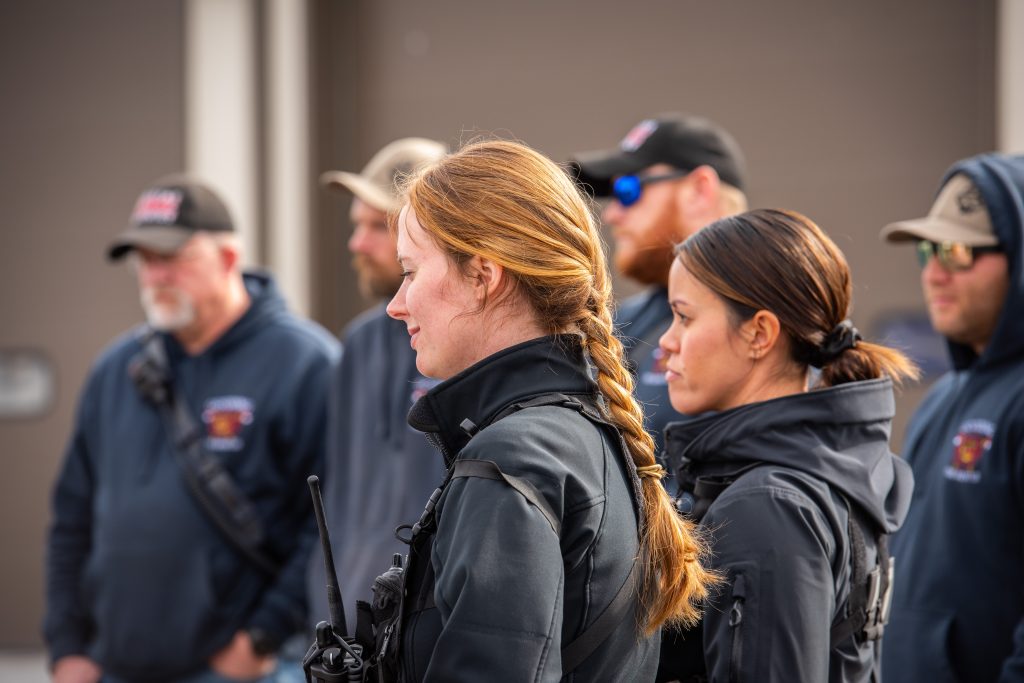
The Idaho National Guard’s 101st Weapons of Mass Destruction Civil Support Team trained alongside firefighters from Gooding, Bliss and Hagerman Feb. 2 in Gooding, Idaho. The training was designed to provide a better understanding of how first responders in these small rural Idaho towns can integrate the CST’s assets and expertise with their own to enhance effectiveness in emergency situations where hazardous materials or chemicals may be a key consideration.
Kevin Hungate, a U.S. Department of Energy regional manager for Radiological Assistance Program Team 6, was on site to observe the training as well. He said building relationships with Idaho’s first responders is key to more effective integration if they ever find themselves working together in a real-world scenario in the future.
“Training evolutions like this give us the opportunity to meet these other agencies and build trust,” said Hungate. “These are really good relationship building tools for us.”
The training began with a capabilities brief and tabletop exercise to help familiarize the firefighters with the ways in which the CST can help departments evaluate and contain affected areas, freeing up first responders to focus on more immediate tasks or emerging threats.
The CST Guardsmen then provided a live demonstration of specialized technology and techniques they use to scan and detect potentially harmful chemical agents and radiological sources. The exercise wrapped up with a demonstration of personnel decontamination procedures as they exited a notional “hot zone.”
Gooding Fire Chief Steven Bishop said the training was valuable to him and his firefighters.
“I wasn’t aware of this team at all until they called and talked to us,” said Bishop. “We have limited capabilities in this area, so this is very beneficial to hear about. It’s another resource we can use in certain types of situations that we didn’t have before.”
The 101st WMD CST is capable of providing around-the-clock response and support to requesting first responders and can provide identification of chemical, biological and radiological agents; recommendations for mitigation, medical treatment and follow-on resources; and on-site communications connectivity.
Lt. Col. John McDaniel, commanding officer of the 101st, said the unit’s outreach program is designed to help foster relationships and build on mutual understanding of each agency’s capabilities, limitations and operational demands to enhance their ability to work together effectively in times of crisis.
“Any time we have a chance to work with emergency managers from our neighboring communities, that’s a huge win for us and for the community,” said McDaniel.
Flyers Fueling the Fight: IDANG pilots refuel A-10s during training exercise
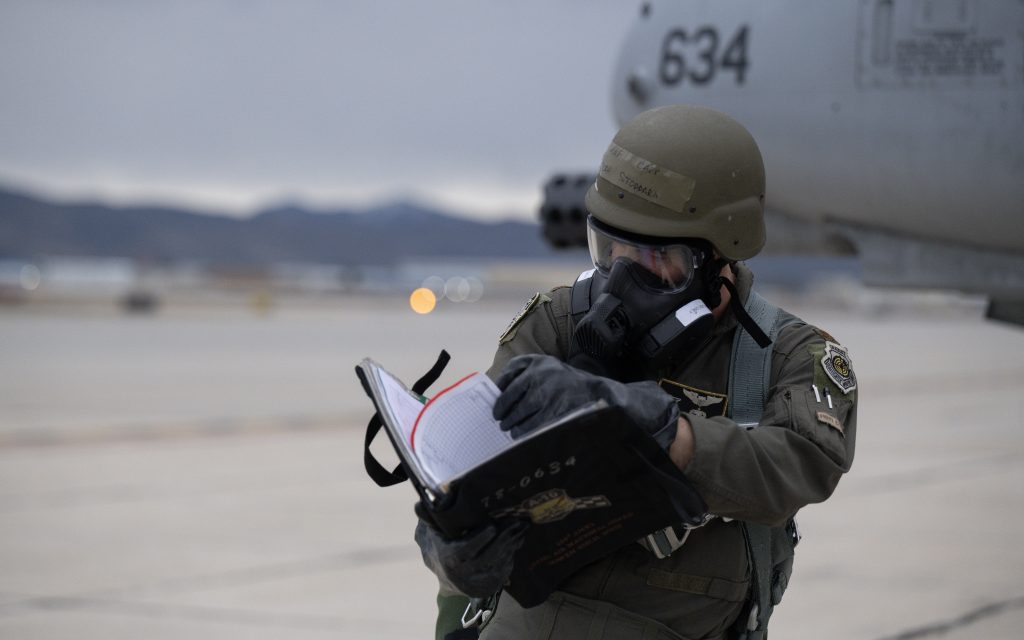
A-10 Thunderbolt II pilots from the 190th Fighter Squadron, part of the 124th Fighter Wing, Idaho Air National Guard, participated in a training exercise Feb. 1-2.
The pilots landed at Jocelyn Field, Magic Valley Regional Airport in Twin Falls, turned their own jets, and continued training exercises.
Landing at an airport that military pilots don’t use every day allows them to practice agile combat employment (ACE), which is a proactive and reactive operational scheme of maneuver to increase survivability while generating combat power.
“When thinking within this ACE concept, we may land in a place austere enough that there isn’t support by crew chiefs, especially A-10 trained crew chiefs,” said Col. Ryan Richardson, 124th FW deputy commander, “so pilots need to be familiar with how to service their own aircraft on the turns.”
The training exercise was designed to enhance agility and resilience, preparing for issues that may occur in a combat mission or high-threat environments, said Col. J.R. Williams, 124th Operations Group Commander.
“Specifically, the 124th Fighter Wing is testing command and control capabilities and concepts of operation while generating air power from different locations, all at a moment’s notice,” Williams said.
Although prior coordination with other military units, local airport authorities, and community partners took place, this simulated training mirrors what military aircrews might be faced with in a deployed environment.
“This is a 190th Fighter Squadron focused exercise,” said Richardson, “but we’re getting lots of support from other agencies.”
The IDANG pilots also practiced combat search and rescue with support from the Idaho Army National Guard’s UH-60 Black Hawks out of Gowen Field. Additionally, Navy EA-18G Growlers from Electronic Attack Squadron 135 in Washington integrated into some of the tactical training in the airspace. The A-10s were supported inside of the airspace by the 266th Range Squadron, an IDANG tenant unit located at Mountain Home Air Force Base in Idaho. They provided threat emitters to provide a realistic, contested training scenario.
“The flying training itself is similar to the training that we do daily, but the integration and the simulated war-time scenario of the exercise makes it more complex,” Richardson said.
A C-130 Hercules from the 152nd Airlift Wing, Nevada Air National Guard, also supported the exercise by transporting military members from Gowen Field to Twin Falls. Crew chiefs arrived at the regional airport and served as instructors for the pilots and as safety observers to make sure everything was done correctly.
“We’re proud and excited to be able to operate out of Twin Falls, and we’re grateful for the support of the airport,” said Richardson. “This is fantastic training that’s going to make us more capable in both our federal and our state mission. We are extremely fortunate to be able to get this kind of training in our backyard.”
Total Force: Army, Air, Navy train together in mass casualty combat exercise
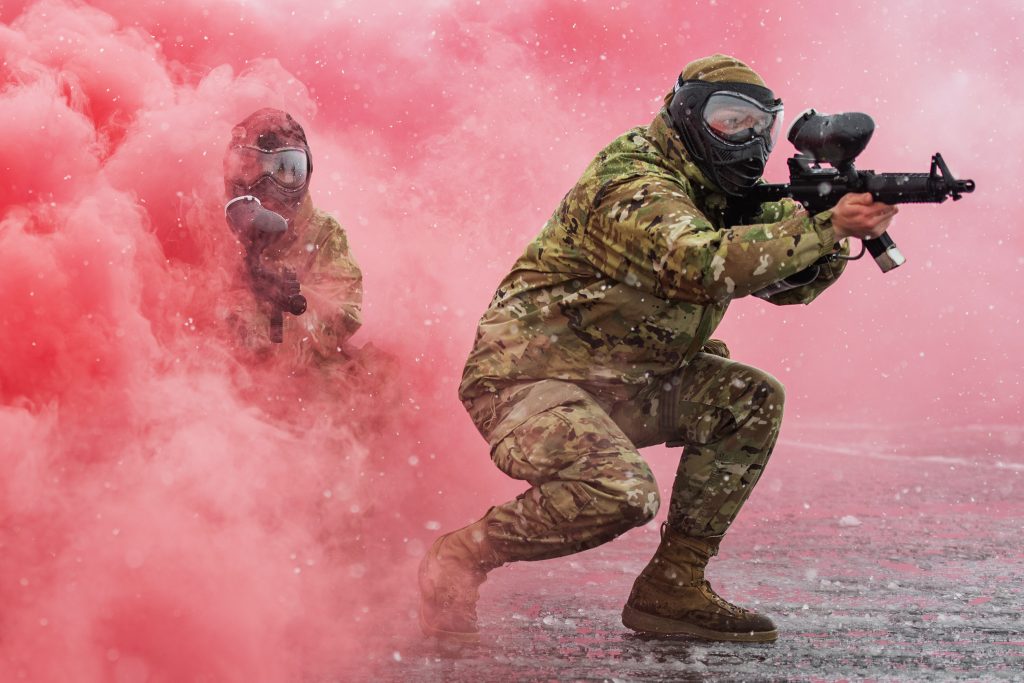
Master Sgt. Becky Vanshur/Idaho Military Division Public Affairs
BOISE, Idaho – A deep breath in, deep breath out. An Airman from the Idaho Air National Guard holds his weapon steady in front of him, pressing it against his shoulder, finger on the trigger, his body low to the ground. He takes a small, strategic step into the plume of smoke swirling around him. Surrounded by a blanket of red smoke makes it hard to see his battle buddy but he knows his counterpart, a Soldier from the Idaho Army National Guard’s Medical Detachment, is close behind him.
The red smoke is used to conceal the medical team’s movements as they defend their medical structures and personnel who are being ambushed while conducting Tactical Combat Casualty Care on the battlefield. The two Guardsmen were among approximately 200 Idaho National Guard Soldiers, Airmen and their active duty and Navy Reserve counterparts who joined forces for a mass casualty combat exercise, Feb. 1-4, near Gowen Field.
“The main focus of this joint services training was to all come together, learn each other’s jobs and create multi-capable Soldiers, Airmen and Sailors on top of learning how to respond in mass casualty scenarios,” said Senior Master Sgt. Davis Nguyen, the 124th Medical Group function area manager. “Equally important, was the ability to perform medical care while under mental and physical stress.”
The Idaho Air National Guard’s Critical Care Air Transport Team, the ground surgical team and other medical personnel from the 124th Medical Group conducted the exercise with the Idaho Army National Guard’s Charlie Company, 145th Brigade Support Battalion Medical Detachment and medevac Soldiers from the 1st of the 168th Aviation Regiment; the Navy Operational Support Center; and active duty Airmen with the 366th Medical Group from Mountain Home Air Force Base.
During the exercise, Soldiers, Airmen and Sailors learned each other’s roles on the battlefield and in the sky. The Idaho Army National Guard’s State Aviation Group incorporated UH-60 Black Hawk helicopters and pilots who responded to 9-Line medevac requests, transporting critical care patients with CCATT officers and medevac Soldiers who stabilized them onboard while flying through simulated combat zones until they reached a higher echelon of care.
“All of our pilots need to practice this piece of the exercise and learn how to fly with patients in the back,” said Chief Warrant Officer 3 Theron Cameron, instructor pilot and medical evacuation officer from the 168th Aviation Regiment. “We need to learn the CCATT’s language to know if they are in the middle of performing a procedure as it cues us to fly as smoothly as possible through the combat areas, while communicating back that we may need to aggressively maneuver around danger.”
Airmen from the 124th Fighter Wing’s Security Forces provided combat lessons on defense and protection, 360-degree security, care under fire and tactical movements with red smoke concealment.
Colin Yates, an Idaho Peace Officers Standards and Training instructor specializing in wounds and trauma for tactical medicine, created realistic wounds on 124th Fighter Wing’s Student Flight role players acting as casualties for a more real-world training experience of TCCC on the battlefield.
Sailors from the NOSC provided the medical logistics support for the simulated deployment location, while learning from both Army and Air medics on tactical field care, casualty evacuation and Roles 1-4 medical care facilities.
“It’s anticipated in future conflicts, there will be a lot more integration with forces. We need to interact with each other and speak each other’s languages,” said Maj. Mark Urban, CCATT physician. “This exercise was developed with that in mind, being able to integrate is really key to that Total Force concept.”
F-16 mission may be coming to Gowen starting in 2027
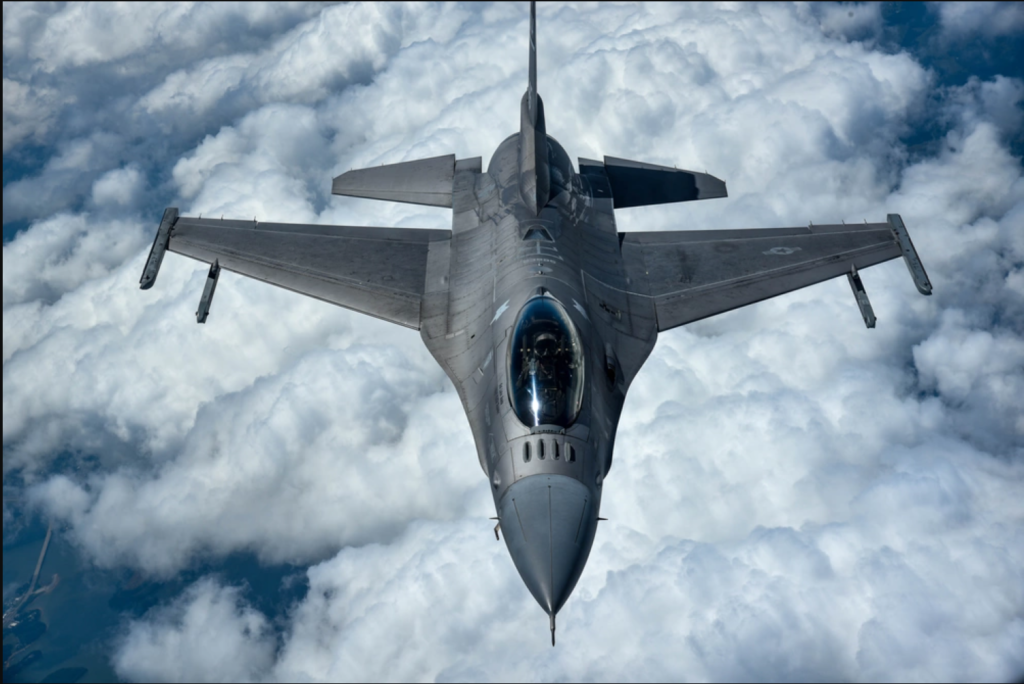
Photo by Tech. Sgt. Teri Eicher , 134th Air Refueling Wing
Gov. Brad Little and members of Idaho’s congressional delegation are proud to announce that the U.S. Air Force has identified the Idaho Air National Guard’s 124th Fighter Wing to potentially receive an F-16 Fighting Falcon mission at Gowen Field in Boise, Idaho.
F-16s are expected to begin arriving at Gowen Field in 2027.
“Idaho is proud of the critical role we have long played in supporting the nation’s defense strategy through the valuable work of the men and women serving at Gowen Field,” Gov. Little said. “The transition to the sophisticated F-16 mission at Gowen Field is the next step in the Idaho Air National Guard’s enduring commitment to safeguarding the liberties and freedoms we hold dear as Americans. This is an exciting step that will benefit the State of Idaho and the United States of America.”
The Idaho Air National Guard has maintained a fighter mission at Gowen Field for more than 75 years. This transition would replace the 18 A-10 Thunderbolt IIs that have been in service at Gowen Field since 1996. The one-for-one exchange would include the same number of F-16s, which are a more advanced and combat-effective aircraft.
The Air Force has planned to divest its aging A-10 inventory for more than a decade. Discussions have been ongoing among Idaho National Guard leaders, and local, state, and federal officials since 2012. Then, the Idaho Air National Guard was notified that their A-10 fleet was identified for divestment by 2015. However, events in Southwest Asia at the time extended the aircraft’s relevance just as the 124th FW embarked on the largest deployment in its history the following year. The 124th FW deployed again in 2020 marking its second largest deployment.
This modernization will better align the Air Force to support the current National Defense Strategy by leveraging the 124th FW’s existing fighter aircraft operations and maintenance expertise once the A-10s at Gowen Field are retired, beginning in the fall of 2026.
“Deterrence is a critical aspect of the National Defense Strategy,” said Brig. Gen. Tim Donnellan, commander of the Idaho Air National Guard. “Today’s near-peer adversaries like Russia and China remind us it’s imperative to ensure our personnel are trained and proficient with the best equipment and tools necessary to fight and win our nation’s wars.”
The Idaho National Guard expects a more detailed timeline from the Air Force in the coming months that will outline the next steps, such as the completion of an environmental impact analysis, planned for the spring of 2025.
The Idaho Air National Guard has been a fixture of the community since 1946. Since then, Idaho National Guard pilots have transitioned through 9 different types of fighter aircraft. With each new aircraft, the organization modifies its noise abatement procedures to minimize the impacts of jet noise on the community.
“Idaho National Guardsmen are rooted in every community in the state,” said Maj. Gen. Michael Garshak, adjutant general of Idaho. “When we are called upon, it’s your friends, families and neighbors coming together to support our community and our nation. Being good stewards of our environment is a priority and we will ensure Boise continues to be one of the most livable cities in the country, regardless of the aircraft we operate.”
Monday’s announcement from the Secretary of the Air Force would mean the continued viability of the Idaho National Guard. With more than $650 million dollars in annual economic impact coupled with nearly 8,000 jobs the Idaho National Guard creates, securing a follow-on fighter mission is a critical part of ensuring Idaho’s prosperity.
Program marches students toward success
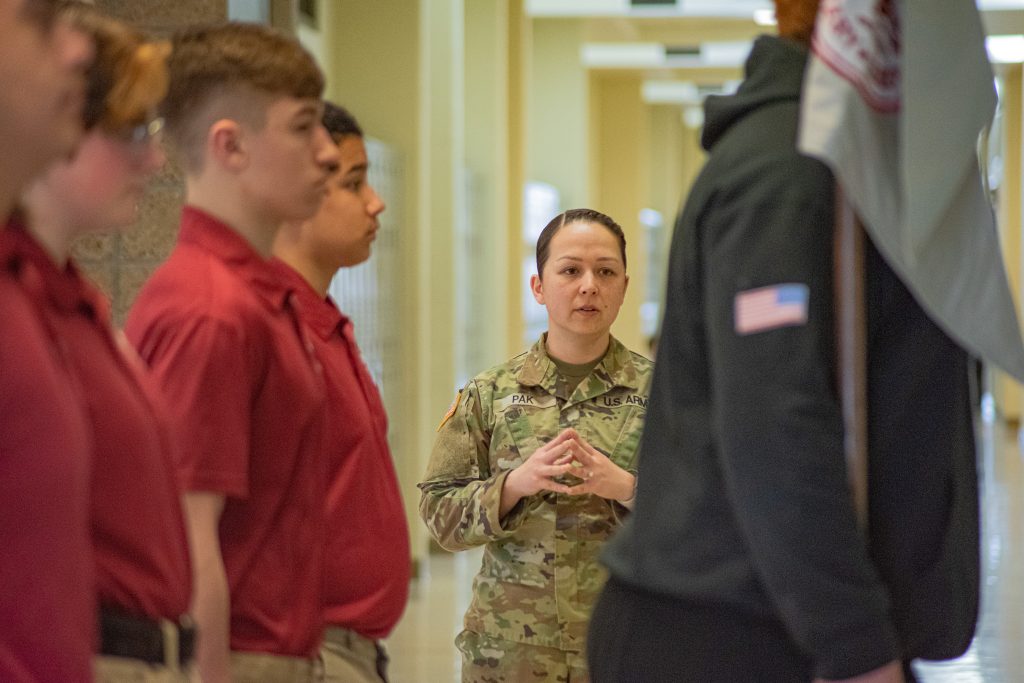
When Kadyn Edwards was a freshman, she was feeling mentally down, failing some of her classes and wanting to turn her life around. Thinking “why not?” she registered for a new class at her high school, not knowing then it would change her life.
“I started taking the class because I was going through a lot at home and school, and just wanted to make a positive change,” said Edwards. “I ended up having an awesome experience and wouldn’t have made it this far without it. Now, I’m earning straight As in all my classes and was just accepted into college.”
The 11th grader at Twin Falls High School is one of nearly 200 ninth through 12 grade students at three high schools to participate in the Idaho Army National Guard-sponsored, and school-facilitated, Military Leadership program each year.
The program offers curriculum similar to Junior ROTC without the federal funding. Like JROTC, the program teaches students about military values, leadership, teamwork, discipline, physical fitness, drill and ceremonies, customs and courtesies and more.
It also uniquely offers students opportunities to serve communities through philanthropy projects, as well as experience military training and career opportunities with Idaho Army National Guard units during drill weekends.
Instructor Staff Sgt. Sarah Pak said Edwards is one example of how the program helps students improve their high school experiences, while also preparing them for their futures. In May, Edwards will complete her third year in Military Leadership, while also graduating high school one year early. After graduation, she plans to study criminal psychology at the College of Southern Idaho.
“The stressors of school can be a lot for kids to handle,” said Pak. “They are trying to figure out who they are and evolve into confident individuals ready to embark on the rest of their lives. I’ve seen this program help so many of them find their ways, even those who aren’t interested in the military, because it gives them somewhere to belong and something to be part of.”
Previously called Military Science, the program was first introduced at Mountain Home High School approximately 20 years ago and was later offered at Twin Falls High School in 2019 and at Canyon Ridge High School in 2021. In August, the Idaho Army National Guard will expand the program to Idaho Falls High School at the request of the school and is currently working to offer the program in Pocatello and northern Idaho.
“I’ve gotten a lot of support from the Idaho Guard and school districts that have really helped me grow the program in the last few years,” said Pak. “They’ve seen the positive impact it has had, not only on students and their families, but also their communities, the economy and Idaho.”
The classes are taught by Idaho Guardsmen who serve as full-time instructors of the program and who have earned their credentialing, approved by the Idaho State Board of Education, through the Army Basic Instructor Course on Gowen Field. They also meet school district requirements, including background checks and drug testing evaluations.
 Official Government Website
Official Government Website